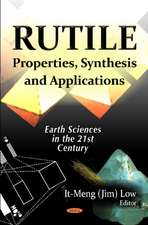Statistical Models for Optimizing Mineral Exploration
Autor J.G. De Geoffroy, T.K. Wignallen Limba Engleză Paperback – 13 oct 2011
Preț: 403.15 lei
Nou
Puncte Express: 605
Preț estimativ în valută:
77.14€ • 80.76$ • 63.83£
77.14€ • 80.76$ • 63.83£
Carte tipărită la comandă
Livrare economică 05-19 aprilie
Preluare comenzi: 021 569.72.76
Specificații
ISBN-13: 9781461290384
ISBN-10: 1461290384
Pagini: 448
Ilustrații: 444 p.
Dimensiuni: 178 x 254 x 24 mm
Greutate: 0.77 kg
Ediția:Softcover reprint of the original 1st ed. 1987
Editura: Springer Us
Colecția Springer
Locul publicării:New York, NY, United States
ISBN-10: 1461290384
Pagini: 448
Ilustrații: 444 p.
Dimensiuni: 178 x 254 x 24 mm
Greutate: 0.77 kg
Ediția:Softcover reprint of the original 1st ed. 1987
Editura: Springer Us
Colecția Springer
Locul publicării:New York, NY, United States
Public țintă
ResearchCuprins
1 Application of computerized geomathematical models to the optimization of exploration programs.- 1.1. General statement: optimization of the mineral exploration sequence.- 1.2. Types of geomathematical models used for optimizing mineral exploration.- 1.3. Construction of a data base for the optimized search for six types of ore deposits in five continents.- 2 Deterministic, heuristic and univariate stochastic models used for optimizing mineral exploration.- 2.1. Foreword: types of models used in the optimized ore deposit search.- 2.2. Deterministic models.- 2.3. Heuristic models.- 2.4. Univariate stochastic models.- 2.5. Modelling of economic & geometric parameters of ore deposits.- 2.6. Modelling of occurrence parameters of ore deposits.- Exercises.- 3 Statistical pooling of regions to assist the optimization of world-wide ore search programs.- 3.1. General statement: rationale of statistical pooling of regions.- 3.2. Testing of population commonality.- 3.3. Sequential testing of population commonality.- 3.4. Application of sequential testing procedure to assist the world-wide search for six types of ore deposits.- 3.5. Application of sequential testing to assist continent-wide search programs for six types of ore deposits.- Exercises.- 4 Probabilistic models for the optimal detection of ore deposits by airborne and ground exploration programs.- 4.1. General statement: detection of ore deposits based on Geometric Probability.- 4.2. Detection of randomly oriented ore deposits by airborne surveys on grids of various designs.- 4.3. Detection of randomly oriented ore deposits by ground surveys or vertical drilling on square grids.- 4.4. Detection of oriented ore deposits by airborne and ground surveys and drilling programs. Application of Dynamic Programming.- 4.5. Optimization of airborne and ground field surveys and drilling programs based on detection probability models.- 4.6. Selection of ore deposit types and regions of search based upon the detectability criterion.- 4.7. Optimal selection of region-ore deposit types based on the discounted payoff criterion.- Exercises.- 5 Application of the General Linear Model and Operations Research models to the optimization of field exploration and development planning.- 5.1. Theoretical background for the GLM.- 5.2. Application of regression analysis to various mineral exploration problems.- 5.3. Application of trend factor and residual trend factor analyses to field exploration programs.- 5.4. Application of Operations Research models to development planning.- Exercises.- 6 Multivariate Bayesian classification models: Application to the optimal selection of prospecting areas and exploration targets.- 6.1. General statement.- 6.2. Optimal selection of prospecting areas and exploration targets based on control data.- 6.3. Optimal selection of exploration targets without control data.- Exercises.- 7 The Expert computerized system for optimizing mineral exploration.- Appendices.- A.1. List of names of ore deposits included in data base.- A.3. SEQPOOL computer programs.- A.4. OPTGRID computer programs.- A.5. FACTOR-TREND computer programs.- A.6. Linear Programming dual simplex computer program.- A.7. CLASSIFICATION computer programs.- A.8. Data lists for exercises.- A.9. Measurement conversion table and statistical tables.- A.10. Answers to selected exercises.









